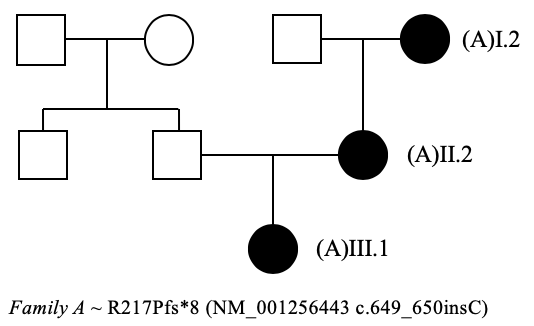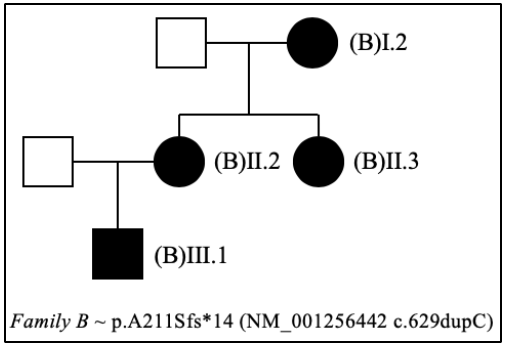Session Information
Date: Tuesday, September 24, 2019
Session Title: Dystonia
Session Time: 1:45pm-3:15pm
Location: Les Muses Terrace, Level 3
Objective: To describe the different clinical syndromes associated with PRRT2 mutations in two different families
Background: Mutations in the Proline-Rich Transmembrane Protein 2 (PRRT2) gene are associated with a wide phenotypic spectrum including Paroxysmal Kinesigenic Dyskinesia (PKD), benign infantile epilepsy (BIE), PKD with infantile convulsions, hemiplegic migraine and episodic ataxia
Method: A neurologist with expertise in movement disorders collected familial and clinical history and performed neurological examination of the affected family members. EEG and brain MRI of the probands were performed
Results: Family A [figure 1]: The PRRT2 R217Pfs*8 (NM_001256443 c.649_650insC) heterozygous mutation segregated with neurological disease in the family. Subject (A)III.1 presented infantile-onset epilepsy. The attacks, characterized by jaw and limb clonus and retained consciousness, lasted for 20’’ to 2’ with a frequency of up to 3 times a day. The neurological examination between crises and the brain MRI were normal. (A)III.1 started a therapy with carbamazepine (CBZ) 10 mg/kg die, which induced total remission of seizures. Her mother ((A)II.2) was affected by PKD presenting dystonic crises triggered by movements and responsive to CBZ. Her grand-mother ((A)I.2) was diagnosed with classical migraine, responsive to CBZ. Family B [figure 2]: The PRRT2 p.A211Sfs*14 (NM_001256442 c.629dupC) heterozygous mutation segregated with neurological disease in the family. Subject(B)II.2 presented episodes of dysphagia and choreoathetosis involving lower limbs and trunk lasting up to one minute; the episodes occurred 2-3 times per month and were triggered by fever and physical activity. The neurological examination between crisis and the brain MRI were normal. The EEG showed fronto-temporal slow and sharp-wave alterations on the left hemisphere. The mother, aged 80 ((B)I.2), the sister, aged 56 ((B)II.3), and the son, aged 25 ((B)III.I) were affected with the same disorder
Conclusion: PRRT2 mutations are associated with a wide range of phenotypic manifestations, such as episodic movement disorders, epilepsy, and migraine. Considering the intrafamilial variability reported here, all the phenotypic differences cannot be explained by the different causative mutations only. Many other factors, such as genetic modifiers and early environmental triggers, can be responsible for the wide clinical spectrum associated with PRRT2 mutations
To cite this abstract in AMA style:
M. Vizziello, R. Dilena, A. Giacobbe, E. Monfrini, G. Franco, A. Di Fonzo. PRRT2 mutations are associated with a wide intrafamilial ad interfamilial phenotypic variability [abstract]. Mov Disord. 2019; 34 (suppl 2). https://www.mdsabstracts.org/abstract/prrt2-mutations-are-associated-with-a-wide-intrafamilial-ad-interfamilial-phenotypic-variability/. Accessed December 29, 2025.« Back to 2019 International Congress
MDS Abstracts - https://www.mdsabstracts.org/abstract/prrt2-mutations-are-associated-with-a-wide-intrafamilial-ad-interfamilial-phenotypic-variability/


